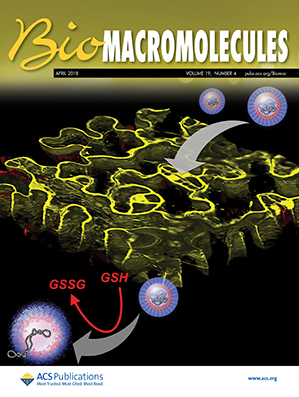Mechanically Activated Starch Reticular Nanostructure Traps Ferulic Acid as a Structural and Functional Cargo
IF 5.4
2区 化学
Q1 BIOCHEMISTRY & MOLECULAR BIOLOGY
引用次数: 0
Abstract
Upon the scalable utilization of polyphenols, the design of their composites with polymers has received a great deal of attention. However, the starch polymer has a weak loading of hydrophobic polyphenols typically through noncovalent interactions without biochemical catalysts. Here, we tailor a reticular starch nanostructure from a starch nanosphere precursor (preSNS) that traps ferulic acid (FA) via esterification. The preSNS-FA network is activated by a green physical method via dynamic high-pressure microfluidization, exhibiting an exceptionally higher content of FA (∼38.0%) compared with the conventional starch group (only ∼1.5%). SEM, FTIR, XRD, 13C NMR, 1H NMR, and XPS results as well as molecular dynamics simulation comprehensively confirm the changes in architecture and hydrogen bonding modes with the formation of −COOR–. The preSNS-FA network also has an enzymatic hydrolysis resistance (up to 83.8%). Collectively, this work establishes a high-performance and catalyst-free synthetic route toward an esterified polyphenol complex network with potential applications in nutrient delivery, food packaging, and agriculture fields.
- Download: Download high-res image (184KB)
- Download: Download full-size image
机械活化淀粉网状纳米结构作为结构和功能货物捕获阿魏酸。
随着多酚的大规模利用,其与聚合物的复合材料的设计受到了极大的关注。然而,淀粉聚合物具有疏水多酚的弱负载,通常通过非共价相互作用而没有生化催化剂。在这里,我们从淀粉纳米球前体(preSNS)定制网状淀粉纳米结构,通过酯化捕获阿魏酸(FA)。preSNS-FA网络通过动态高压微流化的绿色物理方法激活,与传统淀粉组(仅为~ 1.5%)相比,显示出异常高的FA含量(~ 38.0%)。SEM、FTIR、XRD、13C NMR、1H NMR、XPS结果以及分子动力学模拟全面证实了- coor -的形成对结构和氢键模式的影响。preSNS-FA网络还具有酶水解抗性(高达83.8%)。总的来说,这项工作建立了一个高性能和无催化剂的合成途径,以酯化多酚复合物网络,在营养输送,食品包装和农业领域具有潜在的应用前景。
本文章由计算机程序翻译,如有差异,请以英文原文为准。
求助全文
约1分钟内获得全文
求助全文
来源期刊

Biomacromolecules
化学-高分子科学
CiteScore
10.60
自引率
4.80%
发文量
417
审稿时长
1.6 months
期刊介绍:
Biomacromolecules is a leading forum for the dissemination of cutting-edge research at the interface of polymer science and biology. Submissions to Biomacromolecules should contain strong elements of innovation in terms of macromolecular design, synthesis and characterization, or in the application of polymer materials to biology and medicine.
Topics covered by Biomacromolecules include, but are not exclusively limited to: sustainable polymers, polymers based on natural and renewable resources, degradable polymers, polymer conjugates, polymeric drugs, polymers in biocatalysis, biomacromolecular assembly, biomimetic polymers, polymer-biomineral hybrids, biomimetic-polymer processing, polymer recycling, bioactive polymer surfaces, original polymer design for biomedical applications such as immunotherapy, drug delivery, gene delivery, antimicrobial applications, diagnostic imaging and biosensing, polymers in tissue engineering and regenerative medicine, polymeric scaffolds and hydrogels for cell culture and delivery.
 求助内容:
求助内容: 应助结果提醒方式:
应助结果提醒方式:


